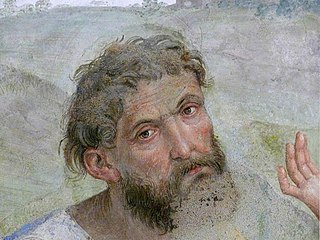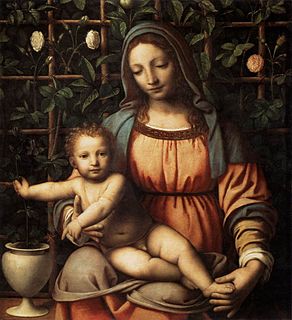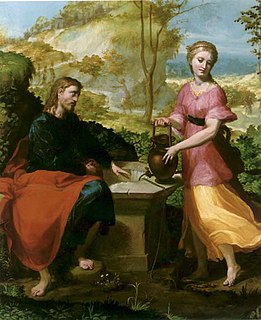
Pintoricchio or Pinturicchio whose birth name was Bernardino di Betto, also known as Benetto di Biagio or Sordicchio, was an Italian painter during the Renaissance. Born in Perugia in 1454 and dying in Siena in 1513, Pintoricchio acquired his nickname because of his small stature. He also used it to sign some of his 15th and 16th century artworks.

Lo Spagna, "the Spaniard" in Italian, was a painter of the High Renaissance, active in central Italy. His name was Giovanni di Pietro, but he was known as Lo Spagna because he was born in Spain. After Raphael, he was a main pupil and follower of the Umbrian painter Perugino, whose style his paintings develop. He should not be confused with Pietro di Giovanni D'Ambrogio of Siena.

Bernardino Luini was a North Italian painter from Leonardo's circle during the High Renaissance. Both Luini and Giovanni Antonio Boltraffio were said to have worked with Leonardo directly; he was described as having taken "as much from Leonardo as his native roots enabled him to comprehend". Consequently, many of his works were attributed to Leonardo. He was known especially for his graceful female figures with elongated eyes, called Luinesque by Vladimir Nabokov.

Ambrogio Borgognone was an Italian painter of the Renaissance period active in and near Milan.

Vincenzo Foppa was an Italian painter from the Renaissance period. While few of his works survive, he was an esteemed and influential painter during his time and is considered the preeminent leader of the Early Lombard School. He spent his career working for the Sforza family, Dukes of Milan, in Pavia, as well as various other patrons throughout Lombardy and Liguria. He lived and worked in his native Brescia during his later years.

Michelangelo Anselmi was an Italian Renaissance-Mannerist painter active mostly in Parma.

The Certosa di Pavia is a monastery and complex in Lombardy, northern Italy, situated near a small town of the same name in the Province of Pavia, 8 km north of Pavia. Built in 1396–1495, it was once located on the border of a large hunting park belonging to the Visconti family of Milan, of which today only scattered parts remain. It is one of the largest monasteries in Italy.

Cesare Nebbia (c.1536–c.1622) was an Italian painter from Orvieto who painted in a Mannerist style.

Bernardino Gatti was an Italian painter of the Renaissance, active mainly in Parma and Cremona. He is also commonly called il Sojaro.
Bernardino Lanini or Lanino was an Italian painter of the Renaissance period, active mainly in Milan.

The Shrine of Santa Maria della Steccata is a Greek-cross design Renaissance church in central Parma, Italy. The name derives from the fence or steccato used to corral the numerous devotees who visited a venerated image of the Madonna. A Nursing Madonna is enshrined within, crowned on 27 May 1601 by a Marian devotee, Fray Giacomo di Forli of the Capuchin order.

Giovanni Battista Benaschi, or Beinaschi, (1636–1688) was an Italian painter and engraver active in the Mannerist and Baroque style.
Girolamo di Bernardino was an Italian painter of the Renaissance period. He was born in the Friuli and lived at Udine. He decorated the churches at Lestizza and Carmona with frescoes in 1511 and 1518. He painted a Coronation of the Virgin for the townhall of Udine.
Agustino or Agostino Da Vaprio was an Italian painter of the Renaissance period. He was living in Pavia in the 15th century, and was one of the artists employed by Ludovico Sforza in Milan, in 1490. He is the author of an altar-piece in San Rimo, Pavia, a Virgin and Child with Saints and donor, dated 1499. A fresco lunette is now in the church of San Giacomo e Filippo, Pavia.

Bartolommeo Bonone, also called Bartolomeo Bernardi, was an Italian painter of the Renaissance period.

San Bernardino alle Ossa is a church in Milan, northern Italy, best known for its ossuary, a small side chapel decorated with numerous human skulls and bones.

The Abbey of Santa Maria di Rovegnano is a Cistercian monastic complex in the comune of Milan, Lombardy, northern Italy. The borgo that has developed round the abbey was once an independent commune called Chiaravalle Milanese, now included in Milan and referred to as the Chiaravalle district.

The Chiesa della Santissima Trinità dei Pellegrini is a Roman Catholic church located on Via dei Pettinari #36 In the rione of Regola of central Rome, Italy. It stands a block away from the Palazzo Spada on Via Capo di Ferro, while a few blocks away on the Via dei Pettinari stands the Ponte Sisto.

Bernardino Fasolo was an Italian painter.
Lorenzo Fasolo (1463–1518), called Lorenzo di Pavia, was a Lombard painter living in the early part of the 16th century, who went from Pavia to Genoa, and was one of the artists employed by Lodovico Sforza in 1490 in the decorations of the Porta Giovia Palace at Milan. His chief work is an altar-piece representing The Deposition from the Cross, which he painted in 1508, for the nuns of Santa Chiara, at Chiavari, where it still remains. The Louvre has by him The Family of the Virgin, dated 1513. His son Bernardino Fasolo was also a painter.















